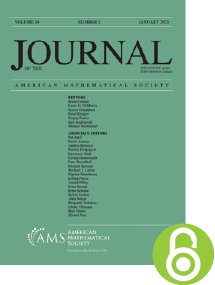A new proof of the Howe Conjecture
HTML articles powered by AMS MathViewer
- by Dan Barbasch and Allen Moy
- J. Amer. Math. Soc. 13 (2000), 639-650
- DOI: https://doi.org/10.1090/S0894-0347-00-00336-2
- Published electronically: April 26, 2000
- PDF | Request permission
Abstract:
The Howe Conjecture, which has formulations for both a reductive $p$-adic group $\mathcal G$ and its Lie algebra, is a statement about the finite dimensionality of certain spaces of $\mathcal G$-invariant distributions. Howe proved the algebra version of the conjecture for $GL(n)$ via a method of descent. Harish-Chandra extended Howe’s method, when the characteristic is zero, to arbitrary reductive Lie algebras. Harish-Chandra then used the conjecture, in both its Lie algebra and group formulations, as a fundamental underpinning of his approach to harmonic analysis on the group and Lie algebra. Many properties of $\mathcal G$-invariant distributions, which for real Lie groups follow from differential equations, in the $p$-adic case are consequences of the Howe Conjecture and other facts, e.g. properties of orbital integrals. Clozel proved the group Howe Conjecture in characteristic zero via a method very different than Howe’s and Harish-Chandra’s descent methods. We give a new proof of the group Howe Conjecture via the Bruhat-Tits building. A key tool in our proof is the geodesic convexity of the displacement function. Highlights of the proof are that it is valid in all characteristics, it has similarities to Howe’s and Harish-Chandra’s methods, and it has similarities to the existence proof of an unrefined minimal K-type.References
- James Arthur, Some problems in local harmonic analysis, Harmonic analysis on reductive groups (Brunswick, ME, 1989) Progr. Math., vol. 101, Birkhäuser Boston, Boston, MA, 1991, pp. 57–78. MR 1168477
- James Arthur, On the Fourier transforms of weighted orbital integrals, J. Reine Angew. Math. 452 (1994), 163–217. MR 1282200, DOI 10.1515/crll.1994.452.163
- James Arthur, Intertwining operators and residues. I. Weighted characters, J. Funct. Anal. 84 (1989), no. 1, 19–84. MR 999488, DOI 10.1016/0022-1236(89)90110-9
- James Arthur, The trace Paley Wiener theorem for Schwartz functions, Representation theory and analysis on homogeneous spaces (New Brunswick, NJ, 1993) Contemp. Math., vol. 177, Amer. Math. Soc., Providence, RI, 1994, pp. 171–180. MR 1303605, DOI 10.1090/conm/177/01916
- F. Bruhat and J. Tits, Groupes réductifs sur un corps local, Inst. Hautes Études Sci. Publ. Math. 41 (1972), 5–251 (French). MR 327923
- Laurent Clozel, Orbital integrals on $p$-adic groups: a proof of the Howe conjecture, Ann. of Math. (2) 129 (1989), no. 2, 237–251. MR 986793, DOI 10.2307/1971447
- Harish-Chandra, Admissible invariant distributions on reductive p-adic groups, Preface and notes by S. DeBacker and P. Sally, University Lecture Series, vol. 16, American Mathematical Society, Providence, RI, 1999.
- Roger Howe, Two conjectures about reductive $p$-adic groups, Harmonic analysis on homogeneous spaces (Proc. Sympos. Pure Math., Vol. XXVI, Williams Coll., Williamstown, Mass., 1972) Amer. Math. Soc., Providence, R.I., 1973, pp. 377–380. MR 0338278
- Roger Howe, The Fourier transform and germs of characters (case of $\textrm {Gl}_{n}$ over a $p$-adic field), Math. Ann. 208 (1974), 305–322. MR 342645, DOI 10.1007/BF01432155
- A. Moy, Displacement functions on the Bruhat–Tits building, preprint.
- Allen Moy and Gopal Prasad, Jacquet functors and unrefined minimal $K$-types, Comment. Math. Helv. 71 (1996), no. 1, 98–121. MR 1371680, DOI 10.1007/BF02566411
Bibliographic Information
- Dan Barbasch
- Affiliation: Department of Mathematics, Cornell University, Malott Hall, Ithaca, New York 14853-4201
- MR Author ID: 30950
- Email: barbasch@math.cornell.edu
- Allen Moy
- Affiliation: Department of Mathematics, University of Michigan, Ann Arbor, Michigan 48109-1109
- MR Author ID: 127665
- Email: moy@math.lsa.umich.edu
- Received by editor(s): April 20, 1999
- Received by editor(s) in revised form: March 7, 2000
- Published electronically: April 26, 2000
- Additional Notes: The authors were supported in part by the National Science Foundation grants DMS-9706758 and DMS-9801264.
- © Copyright 2000 American Mathematical Society
- Journal: J. Amer. Math. Soc. 13 (2000), 639-650
- MSC (2000): Primary 22E35
- DOI: https://doi.org/10.1090/S0894-0347-00-00336-2
- MathSciNet review: 1758757


